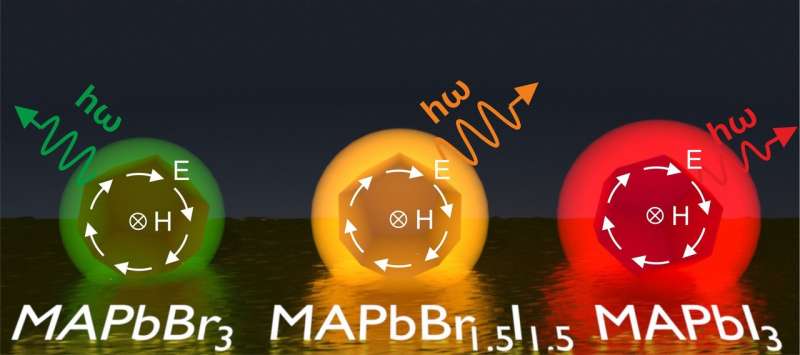Researchers invent light-emitting nanoantennas

Scientists from ITMO University have developed effective nanoscale light sources based on halide perovskite. Such nanosources are based on subwavelength nanoparticles serving both as emitters and nanoantennas and allow enhancing light emission inherently without additional devices. Moreover, perovskite enables tuning of emission spectra throughout the visible range by varying the composition of the material. This makes the new nanoparticles a promising platform for creating compact optoelectronic devices such as optical chips, light-emitting diodes, or sensors. The results were published in Nano Letters.
Nanoscale light sources and nanoantennas have a wide range of applications in several areas, such as ultra-compact pixels, optical detection and telecommunications. However, the fabrication of nanostructure-based devices is complicated since the materials typically used have a limited luminescence efficiency. What is more, single quantum dots or molecules usually emit light non-directionally and weakly. An even more challenging task is placing a nanoscale light source precisely near a nanoantenna.
A research group from ITMO University managed to combine a nanoantenna and a light source in a single nanoparticle. It can generate, enhance and route emission via excited resonant modes coupled with excitons. "We used hybrid perovskite as a material for such nanoantennas," says Ekaterina Tiguntseva, first author of the publication. "Unique features of perovskite enabled us to make nanoantennas from this material. We basically synthesized perovskite films, and then transferred material particles from the film surface to another substrate by means of pulsed laser ablation technique. Compared to alternatives, our method is relatively simple and cost-effective."
While studying the obtained perovskite nanoparticles, the scientists discovered that their emission can be enhanced if its spectra match with the Mie-resonant mode. "Currently, scientists are particularly interested in Mie-resonances related to dielectric and semiconductor nanoparticles," says George Zograf, Engineer at the Laboratory of Hybrid Nanophotonics and Optoelectronics at ITMO University. "Perovskites used in our work are semiconductors with luminescence efficiency much higher than that of many other materials. Our study shows that combination of excitons with Mie resonance in perovskite nanoparticles makes them efficient light sources at room temperature."
In addition, the radiation spectrum of the nanoparticles can be changed by varying the anions in the material. "The structure of the material remains the same, we simply use another component in the synthesis of perovskite films. Therefore, it is not necessary to adjust the method each time. It remains the same, yet the emission color of our nanoparticles changes," says Ekaterina.
The scientists will continue research on light-emitting perovskite nanoantennas using various components for their synthesis. In addition, they are developing new designs of perovskite nanostructures which may improve ultra compact optical devices.
More information: "Light-Emitting Halide Perovskite Nanoantennas". E. Y. Tiguntseva, G. P. Zograf et al. Nano Letters Jan. 24, 2018, DOI: 10.1021/acs.nanolett.7b04727
Journal information: Nano Letters
Provided by ITMO University




















